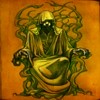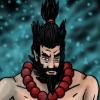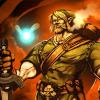On the question of the origin of Orcs, Tolkien did take a final decision about 1959-60, in his latest writings; in The Silmarillion as published we still find the assumption, that Orcs might be corrupted Elves, but Tolkien very clearly rejected this as an impossible idea in some later writings.From a rec.arts.books.tolkien posting:
Tolkien's latest writings on the issue (found in Texts VIII-X of the "Myths Transformed" section in Morgoth's Ring) show him considering many possible origins: corrupted Elves, corrupted Men, very minor Maiar (a small number of original Orcish leaders only), or even beasts given fragments of Morgoth's own will so they would have some measure of independence. Some combination of these origins seems most likely from the texts, though the last of them was probably rejected.
All of these suggested origins still support the notion that Orcs reproduced in the same manner as other races (and therefore that there were female Orcs). This is explicitly discussed in Text X of "Myths Transformed", which states thatMen could under the domination of Morgoth or his agents in a few generations be reduced almost to the Orc-level of mind and habits; and then they would or could be made to mate with Orcs, producing new breeds, often larger and more cunning.
The role of female Orcs in their society is not at all clear.
The lore I refer to is the essay Origin of Orcs which exist as a sort of appendix to a major work entitled Essekenta Eldarinwa or Quendi and Eldar, which Christopher Tolkien describes thus: "with the appendices Quendi and Eldar runs to nearly fifty closely typed pages, and being a highly finished and lucid work is of the utmost interest".
The essay Origin of Orcs can be found in History of Middle-earth Vol. X: Myths transformed, section X
If normal Orcs would have been corrupted Elves, then they would have been 'immortal' like those; this would indeed be contrary to the gist of Tolkien's Legendarium, and in fact contradicting a lot of lore.from Myths transformed, section X: Orcs:
We may assume, then, that the idea of breeding the Orcs came from Melkor, not at first maybe so much for the provision of servants or the infantery of his wars of destruction, as for the the defilement of the Children [of Iluvatar] and the blasphemeous mockery of the designs of Eru. The details of this accomplishment of his wickedness were, however, left mainly to the subleties of Sauron. In that case the conception in mind of the Orcs may go far back into the night of Melkor's thought, though the beginning of their actual breeding must await the awakening of Men.
in a note immediately following above text Christopher Tolkien writes:
When Melkor was made captive, Sauron escaped and lay hid in Middle-earth; and it can in this way be understood how the breeding of Orcs (no doubt already begun) went on with increasing speed during the age when the Noldor dwelt in Aman; so that they returned to Middle-earth they found it already infested with this plague, to the torment of all who dwelt there, Elves or Men or Dwarves.
It was Sauron, also, who secretly repaired Angband for the help of his Master when he returned; and there the dark places underground were already manned with hosts of Orcs before Melkor came back at last, as Morgoth the Black Enemy, and send them forth to bring ruin upon all that was fair. And though Angband has fallen and Morgoth is removed, still they come forth from the lightless places in the darkness of their hearts, and the earth is withered under their pitiless feet.This then, as it may appear, was my father's final view of the question [on the origin of Orcs]: Orcs were bred from Men, and if "the conception in mind of the Orcs may go far back into the night of Melkor's thought" it was Sauron who, during the ages of Melkor's captivity in Aman, brought into being the black armies that were available to his Master when he returned.
The relationship between Orcs and Goblins:
From a rec.arts.books.tolkien posting
The words "Orc" and "Goblin" are essentially identical in meaning, but Tolkien's inconsistent usage in The Hobbit has led to considerable confusion. Still, a clear answer comes from Tolkien's introductory note to later editions of that book, which explains thatOrc is not an English word. It occurs in one or two places but is usually translated goblin (or hobgoblin for the larger kinds). Orc is the hobbits' form of the name given at that time to these creatures.
Some have taken this and other comments in The Hobbit (such as the reference to "the big ones, the orcs of the mountains" near the end of "Riddles in the Dark") to mean that "Goblins" were smaller and "Orcs" larger. However, Tolkien did not generally make this distinction. For instance, the name Orcrist is translated "Goblin-cleaver" in all editions of The Hobbit. Another clear example comes from the chapter "The Riders of Rohan" in LotR, when the companions reach the edge of Fangorn:Upon a stake in the middle was set a great goblin head; upon its shattered helm the white badge could still be seen.
The white badge makes it all but certain that this was one of the large Uruk-hai. In fact, it seems plausible that this was the head of Ugluk himself, slain after a climactic fight sword to sword with Eomer at the end of the battle. If one of the Uruk-hai could be called a goblin, any Orc could.
Edited by Námo, 05 March 2011 - 01:16 PM.

























